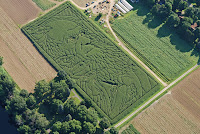ATTENTION!!!ATTENTION!!! CROP CIRCES HAVE BEEN REPORTEDLY SEEN POPPING UP IN MANY FARMS AROUND THE COUNTRY!! OH, I'M SORRY, THOSE ARE CORN MAZES!!
Corn mazes are a popular attraction in rural America. People come from miles around to try their luck at correctly navigating the endless turns, small hills and miles of path to find their way to the exit, some being more adapt at navigating than others are.
Labyrinths or mazes go back for thousands of years. The pyramids in Egypt have tunnels that are in the form of a maze or labyrinth. The design of mazes can also be see in archaeological digs, and as designs on many of the old pottery, walls, and jewelry. Romans designed a lot of their floors and streets with puzzle patterns. In fact, in some towns, the pattern of the streets can be laid out in such a way that there is a center circle and then all roads are similar to a maze that lead into it and out of it. If you don't follow the traffic pattern correctly, one can keep going in circles!
Growing a maze didn't really become popular until the 15th Century, originating in Europe among it's nobility. To help entertain the artistocrat's, garden mazes (made of hedges) were grown. The idea was to find your way in out. England was well-known for it's maze hedges. Britain's oldest garden maze is more that 300 years old. It s the maze at Hampton Court Royal Palace in West London and was planted during the reign of King William III. This maze is 1/3 of an acre in size with winding paths nearly 1/2 mile in length. But, Britain's love mazes so much, due to their popularity, they now have mazes made up of bricks, dirt, water, stones, wood, and paving tiles, as well as glass and mirrors.
Adrian Fisher of Dorset, England is considered the worlds leading maze designer. He's been designing different types of mazes since 1979, achieving 6 Guinness World Records, winning 12 design and expert award and creating over 400 mazes in 23 countries. His company is call Maize Maze in which farmers can get one of his designs.
The first modern corn maze was called "The Amazing Maize Maze" and at the time was the world's largest corn maze. It was designed by Adrian Fisher and Don Frantz.
When planning a corn maze, the first thing that is needed is the plan. How many acres do you want to use? What type of corn? Will you have other structures inside the maze, such as towers? Do you want your corn maze to be based on a theme, notable place or memorable person?
The next step is the corn mazes' design. Many places that have a corn maze tend to go with a theme. Some may choose a more natural theme such as a vase of flowers, a grove of trees, or a mountain range. The bust of a well-known person is also a favorite design. This is where the human aspect and technology start to interact. Once a picture is decided on, a person who designs corn mazes, will input the design into a computer, which will lay out the paths. While the design is being taken care of, the farmer is busy tilling the ground and planting the corn. He will plant the corn in two directions to create a denser crop of corn stalks. When the corn reaches about a foot high, the corn maze designer will use a special tractor equipped with a GPS tracking system to cut the design through the corn field using a plow. The tractor and GPS allows the maze designer to cut an accurate path through the field according to the design layout.
Once the paths have been plowed, there only needs to be basic upkeep of weed removal and widening of paths as the summer progresses and the corn grows tall. This is also the time for placement of path markers and tower installation.
Once the corn reaches approximately 10 feet tall, you can open the fields to the maze wanderers.


















Comments
Post a Comment